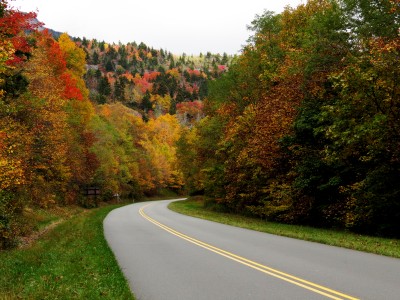BRP Road In Fall Linville By Vicki Dameron.jpg
 Photograph by Vicki Dameron
Photograph by Vicki Dameron As the summer heat dwindles and nights in the mountains dip to cooler temperatures, we all start to anticipate fall and leaf season. For many, leaf season is the best time to visit the Blue Ridge Parkway. Rich colors of yellow, orange and red paint the trees and forest floors. These magnificent hues draw photographers, hikers, picnickers, and road warriors to the nation’s most visited National Park unit. But have you ever wondered how this forest transformation occurs? We spoke with Dr. Chris Ulrey, Plant Ecologist for the National Park Service to learn more about this incredible natural wonder.
What are the best conditions for bright, fall leaf color?
The “best” fall color for an area occurs during the shortening days of autumn when days are bright, sunny and cool, when nights are cool but not below freezing and when there has been ideal rainfall. We are very fortunate in that the most varied fall color, as well as the longest lasting, occurs in the southern Appalachians, where a dozen or more species of trees may change color at slightly different times over the longer fall season. The varied topography of the southern Appalachians from the highest peaks to lowest valleys or the cool north-facing slopes to warm and dry south-facing slopes, means that one is guaranteed excellent fall color if one can find a way to sample all of these environments. The Blue Ridge Parkway offers a unique cross-section of the botanical and environmental diversity of the region.
Where does the color start to change and when?
Leaves begin changing first on the highest peaks and conclude in the lower elevations. Typically, throughout the month of October the park visitor can expect to find good fall color along the Blue Ridge Parkway.
Why do leaves fall?
The evolution of deciduous trees has resulted in the adaptation of producing carbohydrates, via photosynthesis, during the spring, summer and fall. During the winter months, photosynthesis stops and these deciduous trees become dormant. In preparation for winter and to prevent or minimize damage from cold, plant cells switch from production of chlorophyll for growth, to storage of sugars and amino acids, which act as antifreeze for the plant. The tree uses day length and temperature as cues from the environment that winter is coming. Shorter days cause a layer of cork cells called an abscission layer to form at the base of each leaf, gradually closing off the flow of water and nutrients to the leaf. As the supply of chlorophyll dwindles, other pigments that have been present in the leaf all along are slowly unmasked and begin to show through. These are the yellows, oranges and reds.
What’s a good tip for those hoping to see the beautiful colors on the Parkway this fall?
Just enjoy it and take lots of pictures. If you don’t see a lot of changing colors in one spot, keep driving!
Stay Safe on the Road
Fall is a busy time of year on the Blue Ridge Parkway, bringing more cars, motorcycles, cyclists and pedestrians. Stay safe with these tips from Chief Ranger Neal Labrie.
- Speed and Inattention are the leading cause of collisions and injuries. Drive first and please, put the cell phones and devices away.
- Fall brings our highest traffic volumes of the year. Be prepared for slower traffic in general as well as increased foot traffic around vistas and overlooks.
- Late fall brings rapidly changing weather to higher elevations which means snow and ice. Along with falling leaves, road surfaces may be slick especially for motorcycles. Reduce your speed and drive cautiously.